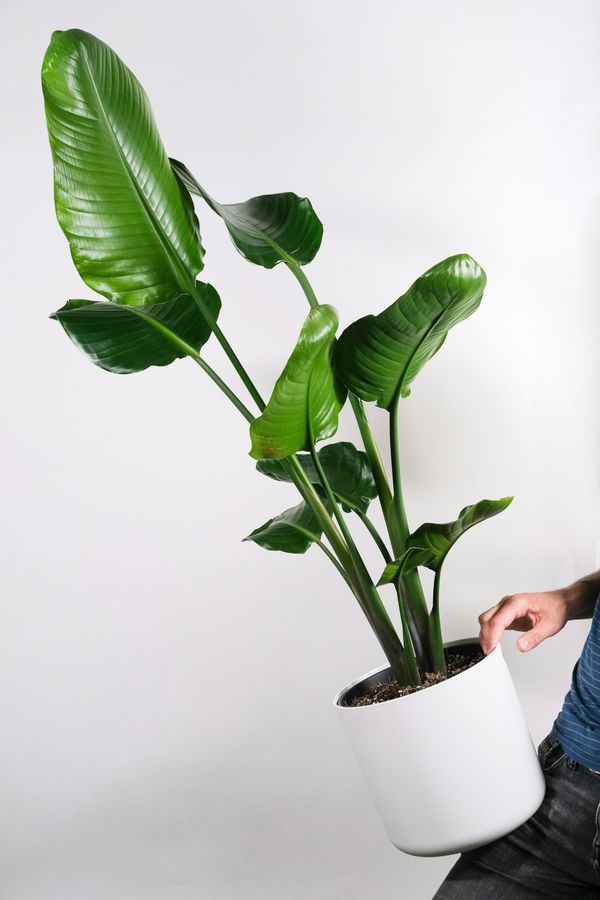Bird of Paradise Care Guide
How to grow and care for Bird of Paradise (Strelitzia reginae)
Welcome to the delightful world of Strelitzia reginae, commonly known as the Bird of Paradise. Known for its striking, exotic flowers resembling a bird in flight, this plant is a wonderful addition to any indoor garden. With the right care, it can thrive indoors and bring a touch of the tropics to your home. In this guide, we'll explore how to nurture your Strelitzia reginae for optimal health and longevity.

Disclosure: This content includes affiliate links, which means we may earn a commission if you click on a link and make a purchase. As an Amazon Associate, we earn from qualifying purchases. This comes at no extra cost to you and helps offset the cost of running Leafwise. Please read our disclaimer for more info.
Table of Contents
Care
Light
The Bird of Paradise thrives in bright, indirect light but can also tolerate full sun when acclimated. A south- or west-facing window is ideal, and a few hours of direct morning or evening sun are beneficial. Insufficient light can lead to slower growth and reduced flowering, so ensure the plant receives ample light to thrive.
Watering
Water your Bird of Paradise thoroughly, keeping the soil consistently moist during the growing season (spring and summer) without waterlogging it. Allow the top two inches of soil to dry out between waterings. In winter, reduce watering as the plant's growth naturally slows. Adjust the watering schedule based on indoor conditions and light exposure.
Temperature & Humidity
Maintain temperatures between 65°F and 70°F (18°C to 21°C). Avoid drafts, sudden temperature changes, and exposure to temperatures below 50°F (10°C). The Bird of Paradise thrives in 50-70% humidity. While average indoor humidity is often sufficient, using a humidifier can help maintain optimal moisture levels, especially in dry environments.
Soil
Use a well-draining, rich, loamy potting mix with a pH between 5.5 and 7.5. A mix designed for cactus, palm, or tropical plants with added compost or organic material ensures proper aeration while retaining moisture.
Fertilization
Feed your Bird of Paradise every two weeks during the growing season (spring and summer) with a balanced fertilizer like a 5-5-5 or 10-10-10 formulation. Follow the manufacturer’s instructions to prevent over-fertilization, which can lead to salt buildup. Reduce feeding to once a month during fall and winter.
Maintenance
Cleaning
Wipe the leaves with a damp cloth regularly to remove dust and improve photosynthesis. Clean leaves also help prevent pest infestations.
Pruning
Prune regularly to remove dead, yellowing, or damaged leaves, as well as old flower stalks. This encourages new growth and reduces the risk of fungal infections. Use clean, sharp pruning shears to avoid damaging the plant. For size management, outer leaves can be removed in early spring.
Repotting
Repot your Bird of Paradise every 2-3 years or when the plant becomes root-bound. Choose a pot that is one size larger, and refresh the soil with a well-draining, nutrient-rich mix. Larger, more established plants can benefit from topdressing instead of full repotting.
Propagation
The Bird of Paradise is typically propagated through division, though propagation from seed is possible (though slow).
Propagating Through Division
- Prepare the Plant: Ensure the plant has multiple mature shoots before dividing.
- Remove and Divide: Carefully remove the plant from its pot and gently separate the rhizomes using a clean, sharp knife. Each section should have at least one fan of leaves and a portion of the root system.
- Replant: Place each division in its own pot with well-draining soil.
- Water Lightly: Water the divisions sparingly at first, keeping the soil lightly moist. Maintain a warm, humid environment until new growth appears.
Common Issues
Pests
Common Pests: Spider mites, aphids, and mealybugs can infest the plant, particularly in dry conditions.
- Symptoms: Yellow spots, webbing, or sticky residue on leaves.
- Solution: Inspect the plant regularly and treat infestations promptly with insecticidal soap or neem oil. Thoroughly cover the leaves, especially the undersides.
Root Rot
Cause: Overwatering or poorly draining soil. This often leads to soggy, oxygen-deprived conditions that promote fungal growth and root decay. Early signs of root rot include yellowing or wilting leaves, a musty smell from the soil, and black, mushy roots when examined.
- Solution: Ensure the pot has adequate drainage, and allow the soil to dry out between waterings. If root rot is detected, remove the affected roots and repot the plant in fresh, well-draining soil.
Yellowing Leaves
Cause: Overwatering, nutrient deficiency, or insufficient light.
- Symptoms: Leaves turn yellow starting at the base or tips.
- Solution: Check the soil moisture and adjust the watering schedule. Ensure the plant receives bright, indirect light and apply a balanced fertilizer during the growing season to address any nutrient gaps.
Browning Leaf Edges
Cause: Low humidity, underwatering, or excessive sunlight.
- Symptoms: Dry, crispy, or browning edges on the leaves.
- Solution: Increase humidity using a humidifier or pebble tray, and ensure the plant is not exposed to harsh, direct sunlight for extended periods.
Cold Damage
Cause: Exposure to temperatures below 50°F (10°C) or sudden cold drafts.
- Symptoms: Wilting leaves, browning or blackened leaf edges, slowed growth, and potential leaf drop.
- Solution: Keep the plant in a warm environment and protect it from frost or sudden temperature drops, especially in winter.
By following these care instructions, your Bird of Paradise will reward you with lush foliage and vibrant flowers, bringing a tropical touch to your indoor or outdoor space.
